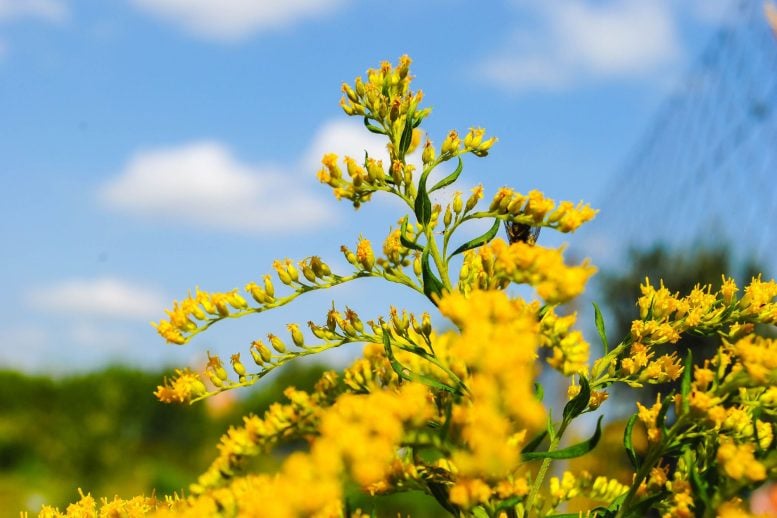
Goldenrod plants can detect other plants nearby through reports of far-red light and adapt their responses when eaten by herbivores, suggesting a form of plant intelligence. Chemical ecologist Andre Kessler makes the case for plant intelligence by defining it as the ability to solve problems based on environmental information. His research shows that goldenrod emits chemicals to signal neighboring plants to produce defenses against pests. This adaptive behavior and communication via volatile organic compounds indicates that plants can process information and respond flexibly to their environment, challenging traditional notions of intelligence. Credit: SciTechDaily.com
New research shows that goldenrods demonstrate a form of intelligence by adapting their responses to herbivores based on the presence of neighboring plants and environmental cues, challenging traditional definitions of intelligence.
Goldenrod can perceive other nearby plants without ever touching them, by detecting reports of far-red light reflected from the leaves. When goldenrod is eaten by herbivores, it adapts its response depending on the presence or absence of another plant nearby. Is this type of flexible, adaptive, real-time response a sign of intelligence in plants?
The question isn’t easy to answer, but Andre Kessler, a chemical ecologist, makes the case for plant intelligence in a recent journal article Signaling and plant behavior.
Defining intelligence in plants
“There are more than 70 definitions published for intelligence purposes and there is no agreement on what those are, even within a given field,” said Kessler, a professor in the Department of Ecology and in evolutionary biology from the College of Agriculture and Life Sciences.
Many people believe that intelligence requires a central nervous system, in which electrical signals serve as a medium for information processing. Some plant biologists liken plant vascular systems to the central nervous system and propose that some sort of centralized entity in the plant allows them to process information and respond. But Kessler strongly disagrees with this idea.

A goldenrod plant.
“There is no strong evidence for any homology with the nervous system, although we clearly observe electrical signals in plants, but the question is how important these signals are to the ability of a plant to process environmental signals? He said.
To make their case for plant intelligence, Kessler and co-author Michael Mueller, a doctoral student in his lab, boiled down their definition to the most basic elements: “The ability to solve problems, based on information that you get from the environment. , toward a particular goal,” Kessler said.
As a case study, Kessler cites his previous research on goldenrod and its reactions when eaten by pests. When leaf beetle larvae eat goldenrod leaves, the plant emits a chemical that informs the insect that the plant is damaged and a poor food source. These airborne chemicals, called volatile organic compounds (VOCs), are also picked up by neighboring goldenrod plants, prompting them to produce their own defenses against beetle larvae. In this way, goldenrods displace herbivores to neighbors and spread the damage.
Experiments and observations
In a 2022 article in the journal Plants, Kessler and co-author Alexander Chautá, Ph.D. ’21, conducted experiments to show that goldenrod can also perceive higher rates of far-red light reflected from the leaves of neighboring plants. When neighbors are present and the goldenrods are eaten by the beetles, they invest more in tolerating the herbivory by growing faster, while also beginning to produce defensive compounds that help the plants fight off insect pests. When no neighbors are present, plants do not accelerate their growth when consumed and chemical responses to herbivores are markedly different, although they still tolerate fairly high amounts of herbivores.
“That would fit our definition of intelligence,” Kessler said. “Depending on the information it receives from the environment, the plant modifies its standard behavior.”
Neighboring goldenrods also demonstrate intelligence when they perceive VOCs that signal the presence of a pest. “Volatile emission from a neighbor is predictive of future herbivory,” Kessler said. “They can use an environmental cue to predict a future situation and then act accordingly.”
Applying the concept of intelligence to plants can inspire new hypotheses about the mechanisms and functions of plant chemical communication, while also changing people’s thinking about what intelligence really means, Kessler said.
This last idea is timely, because
” data-gt-translate-attributes=”({“attribute”:”data-cmtooltip”, “format”:”html”})” tabindex=”0″ role=”link”>artificial intelligence is a topic of current interest. For example, he said, artificial intelligence does not solve problems in order to achieve a goal, at least not yet. “Artificial intelligence, by our definition of intelligence, is not even intelligent,” he said. Rather, it relies on the patterns it identifies in the information it can access.
One idea that interested Kessler came from mathematicians in the 1920s, who proposed that plants perhaps functioned more like beehives. In this case, each cell functions like an individual bee and the whole plant is analogous to a hive.
“This means that the plant brain represents the entire plant without the need for central coordination,” Kessler said.
Instead of electrical signaling, there is chemical signaling throughout the superorganism. Studies by other researchers have shown that each plant cell has broad spectrum light perception and sensory molecules to detect very specific volatile compounds coming from neighboring plants.
“They can sense their surroundings very precisely; as far as we know, every cell can do it,” he said. Cells may be specialized, but they all perceive the same things and communicate via chemical signals to trigger a collective response in growth or metabolism. “I really like this idea,” he said.
Reference: “Induced Resistance to herbivory and the intelligent plant” by André Kessler and Michael B. Mueller, April 30, 2024, Signaling and plant behavior.
DOI: 10.1080/15592324.2024.2345985
The article was supported by a grant from the New Phytologist Fund.